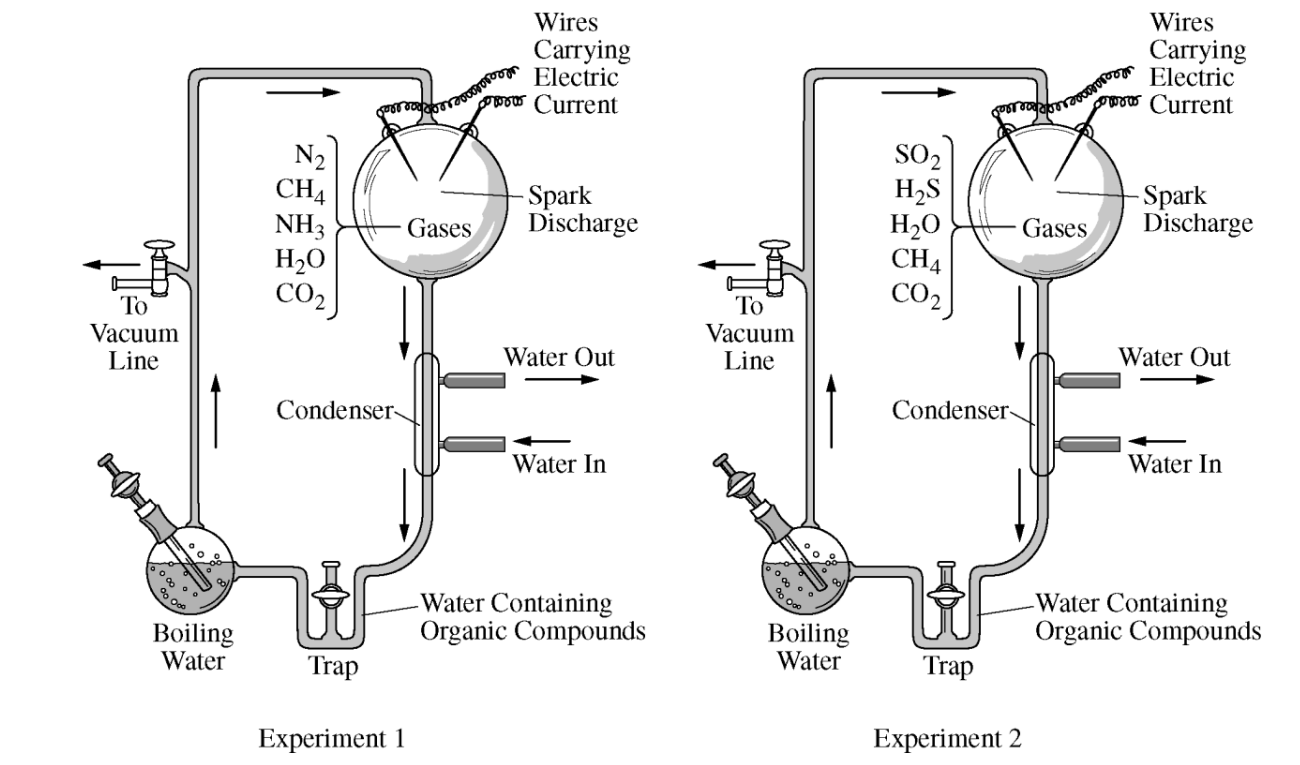Question
In the 1950s, Stanley Miller performed an experiment to investigate the
possible origin of the molecules required for life on Earth. Water vapor,
methane, hydrogen gas, and ammonia were placed in a flask, and
electric charges were applied to the system to simulate atmospheric
conditions that were thought to be prevalent at the time. After many
weeks, amino acids were produced in the system. Which of the
following hypotheses is best supported by the results of this
experiment?
(A) The molecules needed for life on Earth were brought to Earth by a
meteorite.
(B) The molecules needed for life could have formed from inorganic
compounds in Earth’s early atmosphere.
(C) The first molecules needed for life (that were formed in Earth’s
early atmosphere) were RNA.
(D) The first molecules needed for life (that were formed in Earth’s
early atmosphere) were carbohydrates.
▶️Answer/Explanation
Ans:
(B) Miller used molecules thought to have been present in Earth’s early
atmosphere, so the experiment supports this answer. Choice (A) is
incorrect because there was no evidence from Miller’s experiment that
supports this theory about a meteorite. The molecules formed in
Miller’s experiment were amino acids, not RNA or carbohydrates, so
choices (C) and (D) are incorrect.
Question
Which of the following true statements does not support the idea that
RNA was likely the first genetic material?
(A) Cells typically contain about 8 times more RNA than DNA.
(B) RNA plays a central, informational role in protein synthesis.
(C) RNA can replicate by Watson–Crick base pairing rules.
(D) Single-stranded RNA molecules can take on a variety of three-
dimensional shapes and can carry out several catalytic functions.
▶️Answer/Explanation
Ans: A
The fact that cells contain a greater mass of RNA than DNA is not
evidence that RNA was the first genetic material. Water is the most
abundant molecule in the cell, for example, but that does not support its role as a molecule of inheritance. The information contained in genes is used to
make functional RNA molecules such as tRNA and rRNA and proteins.
See the box after answer 6 for a strategy for answering questions asked in
the negative and using the process of elimination.
Question
Fragments from a small meteorite that fell to Earth approximately one
hundred million years after Earth formed were found to contain more
than 80 amino acids. Which of the following true statements is the best
evidence that the amino acids were not contaminants from organisms
from Earth?
(A) The proportions of amino acids found in the meteorite were
similar to those produced in the Miller–Urey experiment
(showing that organic molecules can be synthesized from
inorganic precursors).
(B) The amino acids were present in equal amounts of D- and L-
isomers (mirror image enantiomers), but organisms on Earth can only make and use L-isomers (with rare exceptions).
(C) There are only 20 amino acids that make up proteins in
organisms.
(D) Molecules exposed to extreme conditions often undergo chemical
changes.
▶️Answer/Explanation
Ans: B
It is often easier to think “positively.” In other words, asking “What
evidence would support contamination by amino acids from Earth?” may be
easier to answer than “Which of the following is evidence that amino acids
did not contaminate the meteorite?”
If the amino acids were contaminants from Earth, they would be
present almost exclusively as L-isomers, the specific isomer (specifically,
enantiomer) of all the amino acids that make up proteins in living things.
When amino acids are synthesized by abiotic means, they are produced in a racemic mixture (50% D, “right-handed” enantiomers and 50% L, “left-handed” enantiomers, except for glycine, which doesn’t have D- or L-
isomers). See the box after answer 6 for a strategy for answering questions asked in
the negative and using the process of elimination.
Question
Two groups of students attempted to re-create the primitive atmospheric conditions of early Earth using the apparatus represented below. Each group ran the experiment with different gas mixtures in the apparatus.

Which of the following statements best justifies the claim that the conditions in at least one of the experiments could generate the molecular building blocks essential for life?
(A) The carbon dioxide (CO2) gas and water (H2O) vapor in experiment 1 could react spontaneously to produce the phospholipids required by the first life-forms.
(B) The nitrogen (N2) gas and ammonia (NH3) gas in experiment 1 could provide the elemental nitrogen required for the formation of amino acids.
(C) The sulfur dioxide (SO2) gas in experiment 2 could donate the excited electrons required to drive the process of photosynthesis.
(D) The methane (CH4) gas in experiment 2 could act as the electron acceptor required to complete the process of cellular respiration.
▶️Answer/Explanation
Ans:B
Question.
By discharging electric sparks into a laboratory chamber atmosphere that consisted of water vapor, hydrogen gas, methane, and ammonia, Stanley Miller obtained data that showed that a number of organic molecules, including many amino acids, could be synthesized. Miller was attempting to model early Earth conditions as understood in the 1950s. The results of Miller’s experiments best support which of the following hypotheses?
(A) The molecules essential to life today did not exist at the time Earth was first formed.
(B) The molecules essential to life today could not have been carried to the primordial Earth by a comet or meteorite.
(C) The molecules essential to life today could have formed under early Earth conditions.
(D) The molecules essential to life today were initially self-replicating proteins that were synthesized approximately four billion years ago.
▶️Answer/Explanation
Ans:C
This option is correct. It demonstrates the ability to evaluate scientific questions about the origin of life on Earth by recognizing that the Miller experiment modeled the presumed early atmospheric conditions and, under laboratory conditions, produced biological molecules, such as amino acids, that were required for early life.
